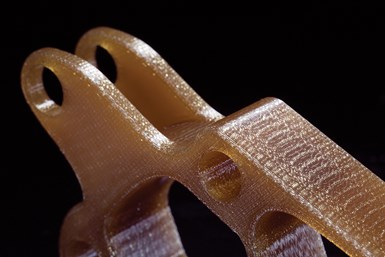Boeing Qualifies Stratasys’ Antero 800NA for 3D Printed Flight Parts
Enhanced chemical resistance and fatigue performance of the PEKK-based material provide Boeing with a new, high-performance option for polymer flight parts.
Share
Read Next

Stratasys' Antero 800NA thermoplastic produces 3D printed parts with the toughness and chemical resistance needed for many aerospace applications.
Boeing has qualified Stratasys’ Antero 800NA thermoplastic for its portfolio of 3D printing capabilities. The qualification means the high-temperature material can now be used on flight parts for Boeing planes. Antero 800NA is a PEKK-based polymer developed specifically for production-grade Stratasys FDM 3D printers. Boeing has released specification BMS8-444 and added the 800NA material to the Qualified Products List (QPL) after an extensive evaluation of the material’s performance. It is the first material from Stratasys qualified by Boeing for use in applications with elevated chemical resistance or fatigue requirements.
“Boeing has recognized the tremendous utility of Antero to meet applications that couldn’t have been 3D printed before,” says Scott Sevcik, Stratasys Aerospace vice president. “Additive manufacturing has tremendous benefits for simplifying aerospace supply chains both in original equipment and MRO, but robust materials for meeting challenging flight requirements have been needed.
The Antero family of materials includes 800NA as well as Antero 840CN03, which is an electrostatic dissipative (ESD) variant. Stratasys provides these materials both for customers who use the Stratasys F900 and Fortus 450mc 3D printers, and as a material option for on-demand customers through Stratasys Direct Manufacturing.
Stratasys is a global supplier of additive manufacturing or 3D printing technology, and is the manufacturer of FDM, PolyJet and stereolithography 3D printers. The company’s technologies are used to create prototypes, manufacturing tools and production parts for industries, including aerospace, automotive, health care, consumer products and education.
Related Content
-
Why AM Leads to Internal Production for Collins Aerospace (Includes Video)
A new Charlotte-area center will provide additive manufacturing expertise and production capacity for Collins business units based across the country, allowing the company to guard proprietary design and process details that are often part of AM.
-
8 Cool Parts From Formnext 2024: The Cool Parts Show #78
End-use parts found at Formnext this year address various aspects of additive's advance, notably AM winning on cost against established processes.
-
Video: For 3D Printed Aircraft Structure, Machining Aids Fatigue Strength
Machining is a valuable complement to directed energy deposition, says Big Metal Additive. Topology-optimized aircraft parts illustrate the improvement in part performance from machining as the part is being built.










